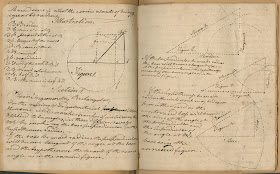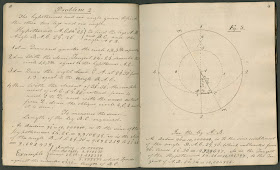 |
| Pike's Mathematical text |
If you attended a school, college or evening mathematics class during the18th century, you would most likely have used a ciphering book rather than a textbook for your studies. A ciphering book was a manuscript notebook that contained mathematical definitions, rules, examples, problems and exercises. It would have included basic arithmetic, as well as more complex subjects including algebra, geometry, and trigonometry. In addition, a ciphering book often emphasized mercantile subjects such as barter, the calculation of interest and surveying. Copied by students, usually from a teacher's own ciphering book, the notebooks became the student's personal "textbook," to be used in class and also as a reference book later in life.
Ciphering books were always written in ink, often with calligraphy headings and illustrations. However, the quality of the script varied significantly.
 |
| Woodward's "System of Plain Trigonometry" |
It appears that Bezaleel Woodward, who would become a professor of mathematics and philosophy, as well as Eleazar Wheelock's son in law, took little care with the script in his notebook "A System of Plain Trigonometry," while he was a student at Dartmouth College. In contrast Samuel A. Kimball, who copied John Hubbard's "A System of Spheric Trigonometry," was more careful in the execution of his penmanship.
 |
| Hubbard's "System of Spheric Trigonometry" |
Another fine example of an 18th century ciphering book is James Pike's untitled volume. Pike was an educator from Somersworth, New Hampshire, who began teaching himself in 1798. The text is divided into chapters with increasing complexity and even has page numbers that are reflected in a contents page. Pike went on to publish two textbooks in his lifetime,
The Columbian Orthographer in 1806 and
The Little Reader in 1814.
According to a M.A. Clements and Nerida F. Ellerton, mathematics professors at Illinois State University, the use of ciphering books declined after 1840, due to the fact that they were no longer important in evaluating the quality of a student's learning or that of an instructor's teaching. In addition, they argue that state education leaders switched their focus from the individual student to that of a graded class.
To see these ciphering books ask for:
MS-1271 (Pike) and
Codex 802415.1 (Woodward). Kimball's cipher book is currently being re-cataloged.



No comments:
Post a Comment